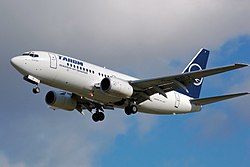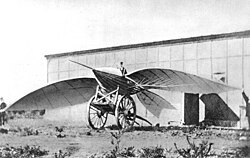Fixed-wing aircraft

A fixed-wing aircraft is a kind of aircraft. An aircraft is a machine that can fly, but is heavier than air. Fixed-wing aircraft are sometimes called airplanes, aeroplanes or sometimes just "planes". All fixed-wing aircraft have wings that use forward airspeed to generate lift.[1] Gliders are fixed-wing aircraft that do not have engines.[2]
Fixed-wing aircraft fly between many cities all over the world, carrying people and cargo. Big cities usually have an international airport, where large fixed-wing airliners operate. Airbus and Boeing are the two biggest makers of large airliners.
Statistics show that riding in a plane is safer than driving in a car.[3]
History
A steam-powered fixed-wing unmanned aerial vehicle that weighed 9 lb (4.1 kg),[4] was built by John Stringfellow, in Chard, Somerset, England in 1848. It could fly by itself without needing to be dropped from high up. There were gliders before this, but they had to fly by being pushed off a building or hill.
The first man who flew (took off, steered, and landed) a motor-powered aircraft was Orville Wright in 1903 in Kitty Hawk, North Carolina, USA.[5]
Advances in technology have made fixed-wing aircraft more efficient. Things like winglets and more efficient turbofans have helped to do this.
Parts
Most fixed-wing aircraft have certain parts in common.
- The wings are the most important part because they are what makes the plane fly. The wings create a force called lift that goes against gravity which makes the plane get off the ground. When air flows around the wing (which happens when the plane moves forward) the wing pushes air down, which in turn pushes the plane up. Lift can also be explained using Bernoulli's principle; since wings are designed so that air goes faster on the top of the wing than on the bottom, the higher pressure on the bottom will push the plane up. Some wings have panels on the back called flaps. Flaps can be extended to make the wing bigger. This makes the wing make more lift, but also more drag. This lets the plane fly slower without stalling, so flaps are often used during takeoff and landing.
- The tail (also called the vertical stabilizer) is a large flat panel normally at the back of the plane. This helps the plane fly straight. Some planes have more than one tail, like the Antonov An-225. Some planes also have no tail, like the Northrop Grumman B-2 Spirit.
- Engines push the plane forward. This makes air flow over the wings, which makes the plane fly. Some planes have propellers that the engine turns. Others have jet engines. Some fixed-wing aircraft, such as gliders, don't have engines. Instead they use gravity to give them forward speed.
- The fuselage is the part of the plane that holds the people and cargo. It is normally shaped like a cylinder. The fuselage might have windows or doors.
- The landing gear or undercarriage is what supports the plane on the ground. It can be wheels if the plane lands on the ground, or floats if the plane lands in the water. If the plane lands in snow, the landing gear usually has skis. Many planes can retract (bring inside the fuselage) their landing gear to make less drag.
Uses
Transport
Fixed-wing aircraft have long been used as airliners for moving passengers from place to place. Cargo aircraft carry cargo across seas and long distances, and passenger aircraft also carry some cargo.
War

The first aircraft for war bombing was used in Libya in 1911 by Italy against the Ottoman Empire. Some fixed-wing aircraft are used by air forces to defend countries. These may be fighter aircraft, using guns or missiles for combat with other aircraft. They may be bombers, dropping bombs on ground targets.
Fixed-wing aircraft allow people to travel longer distances, and faster than ships or trains. Aircraft can fly from New York to London in about 7 hours. It would take one week or more on a ship. Militaries use airplanes to carry their soldiers quickly from place to place.
Airplanes are also used by the military to see many things on the ground easily. This is called surveillance or reconnaissance. Often, fixed-wing aircraft will take photographs as well, which can be used for military planning later.
Image gallery
Fixed-wing Aircraft Media
A Boeing 737 airliner is an example of a fixed-wing aircraft
The fixed wings of a delta-shaped kite are not rigid
Wright Flyer III piloted by Orville Wright over Huffman Prairie, 4 October 1905
Santos-Dumont's self-propelled 14-bis on an old postcard
Curtiss NC-4 flying boat after it completed the first crossing of the Atlantic in 1919, standing next to a fixed-wing heavier-than-air aircraft
A glider (sailplane) being winch-launched
Video clip of a glider sailing over Gunma Prefecture, Japan
References
| Wikimedia Commons has media related to Lua error in Module:Commons_link at line 62: attempt to index field 'wikibase' (a nil value).. |
- ↑ David Anderson; Scott Eberhardt. "How Airplanes Fly: A Physical Description of Lift". The Aviation History Online Museum. Retrieved 26 March 2016.
{{cite web}}: CS1 maint: multiple names: authors list (link) - ↑ Susan Meredith, How Do Aircraft Fly? (New York, NY: Chelsea Clubhouse, 2010), p. 18
- ↑ Flying still safer than driving, even in wake of Sept. 11[dead link]
- ↑ High hopes for replica plane, BBC News
- ↑ "Telegram from Orville Wright in Kitty Hawk, North Carolina, to His Father Announcing Four Successful Flights, 1903 December 17". World Digital Library. 1903-12-17. Retrieved 2013-07-21.











